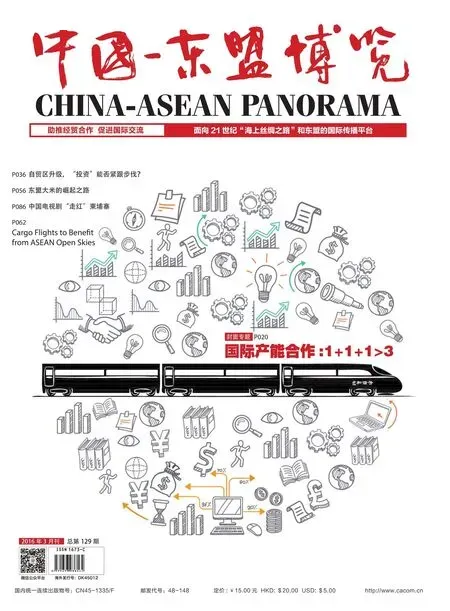Qinzhou Free Trade Port Area: Making a Miracle in Its Marine Transportation
written by Lin Han / translated by Xu Zhiliang
Qinzhou Free Trade Port Area: Making a Miracle in Its Marine Transportation
written by Lin Han / translated by Xu Zhiliang
Qinzhou Free Trade Port Area (QFTPA) was part of sea area at one time, without land, port, shipping route, industries, as well as logistics. But it is precisely because of this that people are shocked by the “Beibu Gulf Speed”created by QFTPA now. QFTPA has been enjoying a booming growth over the past seven years since this port area was approved by the State Council of P. R. C. in 2008, setting a good example for regional cooperation.

Advanced Logistics Depending on Ocean
From 2008 to 2014, QFTPA had completed the construction and operation of the whole port area, among which three years was spent in exploring various development and management models including both business and system, laying a solid foundation for this port area’s reform and development; in 2015, this port area stepped into a new stage of all-round operation and development. “QFTPA, closest to the ASEAN region, is the sole bonded port area in China’s western coastal areas. Located in the most forward position of China-ASEAN international great route and Southwest China’s access to the sea, QFTPA enjoys exceptional regional advantages,” said Wang Xiongchang, Deputy Executive Director of the Management Committee of QFTPA, “besides regional advantages, its strategic superiorities are even more important. Being both the core port area open to the outside of Southwest China and a major portal port to support the construction of the Belt and Road and an upgraded version of CAFTA, QFTPA is bestowed by this era with strategic development opportunities; meanwhile, with the development strategy for upgrading Beibu Gulf Economic Zone being proposed, QFTPA has a more explicit development orientation and construction goal.” QFTPA as a key portal port linking both land-based and sea-based routes of the Belt and Road is aimed at preliminarily establishing a regional logistics center during the 13th Five-Year Plan period. Wang Xiongchang is full of confi dence in the future development of this port area. QFTPA had successively opened various direct shipping routes to major ports throughout the country from 2011 to 2015, saving the costs of enterprises to a large extent. “Besides domestic direct shipping routes, we have opened 9 shipping routes for foreign trade, establishing business relations with many main ports in Asian countries, including Korea, Japan, Vietnam, Thailand, Singapore, Indonesia, Malaysia, Cambodia, as well as China’s Taiwan and Hong Kong. Moreover, international port cooperation has been effectively pushed ahead, for example, the cooperative programlaunched by PSA, PIL and Guangxi Beibu Gulf International Port Group had been implemented successively, and it was put into operation at the end of 2015,” said Wang. In addition, QFTPA has established freight service contacts with over 100 ports in European and North American countries through Singapore and Hong Kong, China.
Little by little aggregation effect of QFTPA’s containers has been reflected, as the number of shipping routes continuously increases. “Especially, QFTPA was specified as the artery port and core zone in Beibu Gulf area after the Decision on Guangxi Beibu Gulf Port’s Development and Reform being issued by Guangxi Zhuang Autonomous Region in October 2014. As you can see from the achievements made over the past year, it is very evident that the containers have been aggregated rapidly, and the total of containers amounts to 946 thousand TEU, with the growth rate of 34 percent.
Based on the openness and cooperation towards ASEAN countries, QFTPA gives high priority to shipping logistics in the first place, for example, China-ASEAN maritime shuttle bus will be built at a higher speed during the 13th Five-Year Plan.

Reform and Innovation: Core Driving Force
At the beginning of 2016, both Peng Qinghua, Secretary of the Party Committee of Guangxi Zhuang Autonomous Region and Chen Wu, Governor of Guangxi made on-thespot investigations and surveys respectively in QFTPA, putting forward specific demands for the development of this port area.
“Because reform and innovation is viewed as the core driving force to promote the development of QFTPA, major breakthroughs have been made in business innovation in 2015,” said Wang. As of September 26, 2015, there were 49 shops gaining access to the international commodity outlet center, with the accumulative total sales of 24.4 million yuan; supervisory platforms, E-commerce platforms and so on were basically completed, etc.
Besides, remarkable progress has been also made in the import of vehicles. “When striving for the goal in quantity, we also plan to quickly forge an industrial chain for importing vehicles by means of financial guidance within 2-3 years,” said Wang. He stated that the state’s first industry fund of imported automobile supply chain has been set up, transforming the traditional way of importing vehicles; meanwhile, the development of general aviation industry also ranks top across the country. All these achievements are attributed to the strong support of the government of Guangxi and the leaders of Qingzhou City, as well as the teamwork between the management committee and Beibu Gulf International Port Group.
QFTPA is proactively committed to advancing the planning, investment attraction, and preliminary work of general aviation industry, among which the planning has been approved, and conducing airlines delivery and finance release. There will be 10 general-purpose airplanes to be delivered as planned.
QFTPA continues with reform and innovation, providing constructive references for the construction of free trade area and pilot zone in the region of China Beibu Gulf. “China (Shanghai) Pilot Free Trade Zone has realized 14 items of system innovation available to the specially supervised area of the customs, while we are qualified for the practice,”said Wang. QFTPA’s transformation and upgrading brought by business innovation and system innovation lays a solid foundation for the application of building China Beibu Gulf Free Trade Pilot Zone, and plays a core demonstration role in creating an upgraded version of CAFTA.

